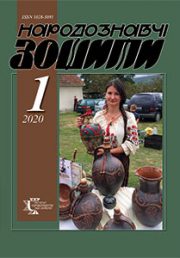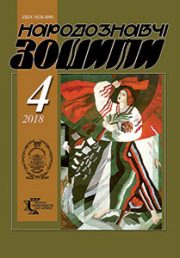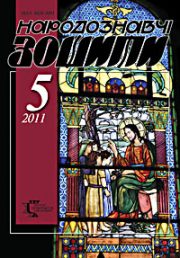The Ethnology Notebooks. 2021. № 6 (162), 1335—1348
UDK 398.3:2-183.5-557-853
DOI https://doi.org/10.15407/nz2021.06.1335/
TRADITIONAL PERCEPTION ABOUT SOUL ON UKRAINIAN POLISSIA (BASED ON FIELD MATERIALS)
BORIAK Olena
- ORCID ID: https://orcid.org/0000-0002-9873-6088
- Doctor of Sciences in History, Senior Researcher
- in the Department of Ethnology of the State Scientific Center
- for Protection of Cultural Heritage from Technological Disasters,
- Peremohy Avenue, 56, 03057, Kyiv, Ukraine,
- Contacts: e-mail: olena.boriak@gmail.com
Abstract. Idea of soul represents condition of a human being as religious and philosophical system. It is brightly presented in the pieces of literature, art, language, oral narratives. Soul is one of the most ancient and important concepts of spiritual culture of Ukrainians. But its complexity, multy-layerness and assessments result into poor research of all its components. In this regard of great interest is a new field material, foremost from Ukrainian Polissia. Potential of regional ethnographic materials, first of all from historical-ethnographic region of Polissia that still keeps archaic examples of polishchuks’ world-view, had been used by the researchers not enough. The goal of the article is the complex research of world-view of polishchuks conceptions, tied to the belief of soul existence. The object of the research is soul as a component of non-material beginning; the subject — features of soul as a visual image of reincarnation, locus of its location, contradictory-ambivalent nature of its essence, ways to «take care» about it etc. In the «earth» life soul lives in human body, and with exhaustion of its life resource other, much broader world had become space of soul. Therefore one has to provide water (food), to hang a towel, to lit a candle, to throw clothes, to lit fire. Soul is: given water, fed, led, transported, led through, put on (clothes), warmed up, taken care of, not disturbed. All these actions «diluted» boundaries between «this» and «that» world. The article for the first time proposes broad massive of fieldwork material, collected during numerous ethnographic expeditions as a result of interviewing of residents of the villages of northern rajons of Volyn’, Rivne, Zhytomyr, Kyiv and Chernihiv oblasts that had suffered from Chornobyl catastrophe. The methodological basis of the study is the principle of systematic and structural-semantic approaches in combination with elements of descriptive-analytical component, synchronous-diachronic and contextual methods of analysis. Despite inevitable modification processes, proposed material still contain traditional archaic perceptions about the soul as extraordinary product of human imagination.
Keywords: Ukrainian Polissia, burial rituals, soul, body, mythological beliefs of polishchuks.
Received 27.08.2021
REFERENCES
- Popovych, M.V. (1985). Worldview of the ancient Slavs. Kyiv [in Ukrainian].
- Kolessa, F. (2001). Beliefs about the soul and the afterlife in Ukrainian funeral and funeral rites. Notes of the Shevchenko Scientific Society. Papers of the section of ethnography and folklore (Vol. ССХLII, pp. 7—82). Lviv [in Ukrainian].
- Zalies’ka, R. (2016). Scientific problems of correspondence between Filaret Kolessa and Mark Azadovsky. Zalies’ka R., Koval’-Fuchylo I. Retrieved from: https://philology.lnu.edu.ua/wpcontent/uploads/2016/12/Rodyna_Kolessiv_Zaleska R_Naukova_problematyka_2013.pdf [in Ukrainian].
- Kis’, R. (1996). Foreword. Studies of integrated culturology. I. Thanatos (Issue 1, pp. 5— 8). Lviv [in Ukrainian].
- Kis’, R. (1996). Covariations of ideas about death as an indicator of culture (an attempt of a cross-cultural vision). Studies of integrated culturology. I. Thanatos (Issue 1, pp. 9—20). Lviv [in Ukrainian].
- Maierchyk, M. (1996). Ornithomorphic conception about the soul (problems of genesis and semiosis). Studies of integrated culturology. I. Thanatos (Issue 1, pp. 92—104). Lviv [in Ukrainian].
- Karakutsia, O. (2002). Phraseologisms of the Ukrainian language with a component «soul» (structural-semantic, ideographic, linguo-cultural aspects). H. ScovorodyKharkiv State Pedagogical University. Kharkiv. Retrieved from: http://www.disslib.org/frazeolohizmy-ukrayinskoyi-movy-z-komponentom-dusha.html [in Ukrainian].
- Prudnykova, T.I. (2005). Phraseological microsystem of «soul» in the Ukrainian language: structural and grammatical aspect. V.I. Vernadsky Scientific Proceedings of the Tavrichesky National University, series «Philology», 2 (Vol. 18 (57), pp. 112—114) [in Ukrainian].
- Skab, M.V. (2007). The concept of «soul» in folklore. Scientific Proceedings of Ternopil National Pedagogical University, series «Linguistics», 1 (16), 407—421 [in Ukrainian].
- Stavyts’ka, Ya.V. (2016). The concept of the soul in the Ukrainian folklore, interpretations at the end of the XIX — the beginning of the XX century. Scientific Proceedings, 44, 77—81 [in Ukrainian].
- Maierchyk, M. (2011) Ritual and body: Structural and semantic analysis of the rites of the Ukrainian family cycle (Pp. 217—261). Kyiv: Krytyka [in Ukrainian].
- Maslowska, E., Kapelus, M., & Jurewicz, J. (Eds.).(2016—2018). Anthropological and linguistic images of the soul in an intercultural perspective (Vol. 1: Soul in the eyes of the world); (Vol. 2: The world through the eyes of the soul); (Vol. 3: Axiosphere of the Soul — Soul in the Axiosphere).Warsaw [in Polish].
- Konobrods’ka, V. (2007). Polissya burial and funeral rites (Vol. 1: Ethnolinguistic studies). Zhytomyr: Polissia [in Ukrainian].
- Ul’ianovs’ka, S.V. (1989). Representation of the spiritual essence of human being in the context of funeral rites. Folk art and Ethnography, 1, 34—40 [in Ukrainian].
- Hilevych, I. (2014). Fieldwork studies of Russian and Bilorussian Ethnologists and Ethnolinguistics in the Ukrainian Polissia territory in the 1945—1980s. The Ethnology Notebooks, 1 (115), 38—47 [in Ukrainian].
- Tolstaya, S., & Tolstoj, N.I. (Ed.). (1999). The soul. Ethnolinguistic Dictionary: in 5 vol. (Vol. 2, pp. 162—167). Moscow [in Russian].
- Tolstaya, S. (2000). Slavic mythological ideas about the soul. Slavic and Balkan folklore. Folk demonology (Pp. 52—95). Moscow [in Russian].
- Tolstaya, S.M., Kabakova, G., & Kont, F. (Eds.). (2005). The body as the abode of the soul: Slavic folk performances. Body in the Russian Culture (Pp. 51—66). Moscow [in Russian].
- Tolstoj, N. (2013). Paganism of the ancient Slavs. In Tolstoj, N., & Tolstaia, S. Slavic ethnolinguistics. Questions of Theory. Moscow [in Russian].
- Vinogradova, L.N. (1999). Material and bodyless forms of existence of the soul. Slavic Studies. Collection for the anniversary of N. Tolstoj (Pp. 141—160). Moscow [in Russian].
- Vinogradova, L.N., & Antonov, D. (Ed.). (2015). Metamorphoses of the soul: From incorporeal substance to material forms. Werewolves and Werewolves: Strategies for Description and Interpretation: Materials of the International Conference (December, 11—12, 2015) (Pp. 33—38). Moscow [in Russian].
- Vinogradova, L. (2008). Death good and bad in the value system of the traditional culture. Categories of life and death in Slavic culture (Pp. 48—56). Moscow [in Russian].
- Vinogradova, L., & Levkievskaya. E. (Eds.). (2012). Folk demonology of Polesie: publications of texts in the records of the 80—90-s of the XX century (Vol. II: Demonologization of Dead People). Moscow. Retrieved from: https://inslav.ru/sites/default/files/editions/2012_narodnaja_demonologija_polesja_2_0.pdf; Vol. III: Mythologization of natural phenomena (2016). Moscow. Retrieved from: https://inslav.ru/sites/default/files/editions/2016_narodnaja_demonologija_polesja_3.pdf [in Russian].
- Levkievskaya, E., & Vinogradova, L. (2012). The deceased. Folk demonology of Polesie: Publications of texts in the records of the 80s — 90s of the XX century (Vol. II: Demonologizing of dead people (Pp. 90—156). Moscow [in Russian].
- Levkievskaya, E., Vinogradova, L. (2012). The soul. Folk demonology of Polesie: Publications of texts in the records of the 80s—90s of the XX century (Vol. II: Demonologizing of dead people (Pp. 15—89) [in Russian].
- Archive-Musium of Traditional Culture of Ukrainian Polissia, State Scientific Center for Protection of Cultural Heritage from Technological Disasters (here in after will not refer). F. АА-Boriak, Rokytne-2006.
- Mel’nychuk, O.S. (Ed.). Etymological dictionary of the Ukrainian language (1982—2012): in 7 vol. (Vol. 2 (1985): D—Koptsi; Vol. 5 (2006): R—T. Kyiv [in Ukrainian].
- F. АА-Boriak, Zarichne-2010.
- F. DА-Boriak, Kamin’-Kashyrs’kyi-2012.
- Toporkov, A.L., Kabakova, G., & Kont, F. (Eds.). (2005). The Body Symbolism in Russian Invocations. Body in the Russian Culture (Pp. 131—146). Moscow [in Russian].
- F. АА-Boriak, Brusyliv-2003.
- F. АА-Boriak, Volodymyrets’-2009.
- F. DА-Boriak, Semenivka-2019.
- F. DА-Boriak, Zhytomyr-2016.
- F. DА-Boriak, Chernihiv-2018
- F. DА-Boriak, Berezne-2013.
- Boriak, O., Vasianovych, O., Scherbak, O., &Skrypnyk, H. (Ed.). Ethnographic image of the modern Ukraine. Collection of folkore and ethnographic fieldwork materials (Vol. 6): Childbirth rituals. Kyiv. Retrieved from: http://www.etnolog.org.ua/pdf/stories/spadshchyna/2016/obryad.pdf [in Ukrainian].
- F. DА-Boriak, Manevychi-2016.
- F. DА-Boriak, Olevs’k-2019.
- F. DА-Boriak, Ljubeshiv-2015.
- F. AA-Boriak, Emil’chyne-2011.
- F. DА-Boriak, Iahotyn-2014.
- F. DА-Boriak Ripky-2017.
- F. AA-Boriak, Zhytomyr-2004.
- Moskalenko, L. (Ed.). (2005). The dialect of the village of Masheve, Chornobyl district (Part 4). Kyiv [in Ukrainian].






